Bald eagles forever
The U.S. bald eagle population is on the rise.
By Emily Sohn
It’s easy to see a bald eagle in the United States. Just look at the official seal on a $1 bill.
To the nation’s founders, the big, white-headed bird represented freedom and majestic beauty, and it quickly became a national symbol. Today, the bald eagle is also an example of an environmental success story.
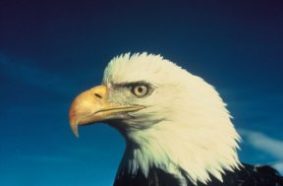 |
|
A bald eagle.
|
| Mike Lockhart, U.S. Fish & Wildlife Service |
In the 1960s, only about 400 breeding pairs of bald eagles remained in the lower 48 states. Now, thousands of bald eagles soar U.S. skies, and their numbers continue to grow.
“You hear a lot of bad news about what happens to wildlife, and species are added to the endangered species list all the time,” says John Kostyack of the National Wildlife Federation in Washington, D.C. But “we do have success stories,” he adds.
Bald eagles have recovered so well that the U.S. Congress may soon remove them from the list of endangered and threatened species. However, scientists are still debating whether this change ought to occur. The final decision should come this summer.
Endangered species
Trouble for bald eagles and other birds began when farmers began to use a chemical called DDT, which protected crops from insects but also killed birds and made the shells of their eggs dangerously thin. The U.S. government banned DDT in 1970, and bird populations started to rebound.
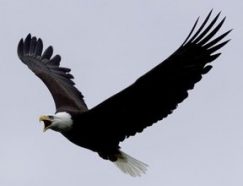 |
|
A bald eagle in flight.
|
| Steve Hillebrand, U.S. Fish & Wildlife Service |
A law called the Endangered Species Act (ESA) also helped. Passed in 1973, the ESA makes it illegal to harm plants and animals listed as endangered or threatened. It also protects their habitats. If anyone wants to build on land where listed species live, scientists must review the proposal first.
“The act is a safety net intended to stop us before we drive a species to extinction,” says Cat Lazaroff of the law firm Earthjustice. “It helps us look before we leap and make decisions that allow us to live side by side with the wildlife in this country.”
The bald eagle’s recovery, Lazaroff says, is a perfect example of how well the ESA can work. It also illustrates how science and the law can team up to battle environmental problems. Organizations such as Earthjustice sometimes go to court to stop construction projects if scientists believe that development will put an endangered species at risk.
Coastline nests
Even though bald eagles are making a strong return, some scientists aren’t sure that these birds should be removed from the endangered species list anytime soon. To qualify for removal, a bird’s population must reach a certain size, and there must be strong evidence that the numbers will stay high.
For the bald eagle, there’s no guarantee of continued population growth, says Bryan Watts. He’s a bird ecologist at the College of William & Mary in Williamsburg, Va. One problem is land development.
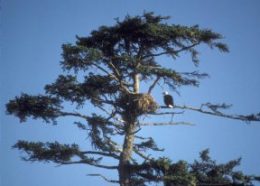 |
|
A bald eagle and its nest.
|
| Mike Jacobson, U.S. Fish & Wildlife Service |
Eagles prefer to build nests along coastlines, Watts says, often in the same places where people want to live too.
“From a biological standpoint, bald eagles have recovered,” Watts says. “But every year we see larger and larger tracts of land being developed. If we look 50 years down the road, we’re concerned that . . . recovery will be reversed due to habitat loss.”
Watts also worries that taking bald eagles off the list might reduce scientific interest in the species. For 50 years, scientists have been monitoring eagle populations and gathering information about how to keep them healthy.
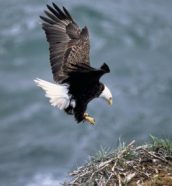 |
|
Bald eagles prefer to live along coastlines.
|
| Dave Menke, U.S. Fish & Wildlife Service |
In one recent study, William & Mary graduate student Catherine Markham, who studies eagle populations in the Chesapeake Bay, found that eagles reproduce best in certain areas of the bay where the salt concentration, or salinity, of the water is low. The Chesapeake Bay is on the eastern coast of the United States.
This tells us that “low-salinity areas have to be the focus of conservation efforts,” Watts says. “That’s where the heart of the [bald eagle] population is.”
Monitoring populations
Yearly monitoring has shown that a bald eagle needs to have an average of 0.7 chick per year to sustain the population, Watts says. When DDT contamination was high, that average dropped to 0.2 in the Chesapeake region. Now, the average is a healthy 1.8 chicks per year.
Keeping an eye on these numbers is essential for identifying population crashes in the future.
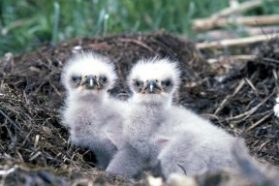 |
|
Bald eagle chicks.
|
| Dave Menke, U.S. Fish & Wildlife Service |
Every March in the Chesapeake Bay, for example, Watts and his colleagues fly above the treetops to count eagle nests. In May, these researchers swoop into the canopy to count eggs. They also climb trees to mark birds. This lets them track the birds’ eating habits and other details of their behavior.
Such monitoring is important, Watts says, because the needs of society conflict increasingly with those of endangered species.
Opinions welcome
The U.S. Fish and Wildlife Service is accepting comments about the proposal to remove bald eagles from the endangered species list until May. If you have an opinion, there are several ways to make yourself heard.
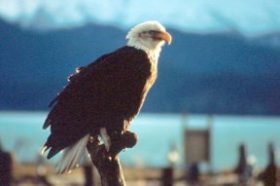 |
|
A bald eagle.
|
| Gloria Meschmeyer, U.S. Fish & Wildlife Service |
Through the Eagles Forever! Web site at http://eaglesforever.org/ , you can write to your senators in the U.S. Congress about bald eagles or about a recent proposal to weaken the Endangered Species Act.
You can also enter a contest by writing a story or drawing a picture about why you think eagles are important to the United States. The winner in each category will win a trip for four to Washington, D.C. The visit includes a behind-the-scenes visit to the National Zoo and meetings with celebrity judges. The deadline is April 30.
Good luck!
Going Deeper:







